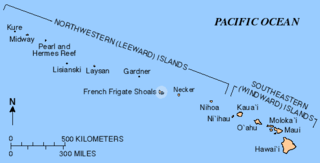
Laysan is one of the Northwestern Hawaiian Islands, located 808 nautical miles northwest of Honolulu at 25°42′14″N171°44′04″W. It comprises one land mass of 1,016 acres (4.11 km2), about 1 by 1+1⁄2 miles in size. It is an atoll of sorts, although the land completely surrounds a shallow central lake some 2.4 m (7.9 ft) above sea level that has a salinity approximately three times greater than the ocean. Laysan's Hawaiian name, Kauō, means 'egg'.

The Laysan finch is a species of Hawaiian honeycreeper, that is endemic to the Northwestern Hawaiian Islands. It is one of four remaining finch-billed Hawaiian honeycreepers and is closely related to the smaller Nihoa finch. The Laysan finch is named for Laysan, the island to which it was endemic on its discovery. It was subsequently introduced to a few other atolls, and its historical range included some of the main islands.

The Laysan albatross is a large seabird that ranges across the North Pacific. The Northwestern Hawaiian Islands are home to 99.7% of the population. This small gull-like albatross is the second-most common seabird in the Hawaiian Islands, with an estimated population of 1.18 million birds, and is currently expanding its range to new islands. The Laysan albatross was first described as Diomedea immutabilis by Lionel Walter Rothschild, in 1893, on the basis of a specimen from Laysan Island.

Agrotis segetum, sometimes known as the turnip moth, is a moth of the family Noctuidae. The species was first described by Michael Denis and Ignaz Schiffermüller in 1775. It is a common European species and it is found in Africa and across Eurasia except for the northernmost parts.

The Laysan millerbird was a subspecies of the millerbird, similar in appearance to the remaining subspecies, the Nihoa millerbird. Its dorsal side was brown, and its belly was grayish. Its name derives from its favorite food, several species of moths of the genus Agrotis commonly referred to as "millers".

Agrotis is a genus of moths of the family Noctuidae. The genus was erected by Ferdinand Ochsenheimer in 1816. A number of the species of this genus are extinct.
The poko noctuid moth is a moth in the family Noctuidae. The species was first described by Arthur Gardiner Butler in 1881.

The Midway noctuid moth, also known as Midway mudworm, is a species of moth in the family Noctuidae. It is now possibly extinct and was endemic to Midway Atoll.

Kerr's noctuid moth is a species of moth in the family Noctuidae.

The Laysan noctuid moth is a species of moth in the family Noctuidae.
The Laysan dropseed noctuid moth was a species of moth in the family Erebidae. The species was first described by Otto Herman Swezey in 1914. This species is now extinct.
The Laysan hedyleptan moth is a species of moth in the family Crambidae. It is endemic to Laysan in the Northwestern Hawaiian Islands.

The Laysan honeycreeper or Laysan ʻapapane is an extinct bird species that was endemic to the island of Laysan in the Northwestern Hawaiian Islands.

Agrotis panoplias, the Kona agrotis noctuid moth, is a species of moth in the family Noctuidae. It is now considered as possibly extinct.
Agrotis dislocata, the lesser native cutworm, is a moth of the family Noctuidae. It was first described by Francis Walker in 1856. It is endemic to the Hawaiian islands of Niihau, Kauai, Oahu, Molokai, Maui, Lanai, Hawaii and Laysan.
Agrotis evanescens is a moth of the family Noctuidae. It was first described by Walter Rothschild in 1894. It is endemic to the Hawaiian island of Laysan.











